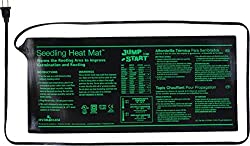It’s that time of year when you can start planning for your planting!
Many people are beginning to plant vegetables and flowers indoors in order to transplant them outdoors when the weather is warm enough. This helps you get a head start on your spring garden. Check out the advice below to see what things you can do to start your indoor seeds.
Growing your own foods in your garden can help you become more self-sufficient - saving you money and allowing you to grow the foods that your family will need. It’s also a great way to help teach children about responsibility and work.
When
The date you determine to plant your seeds will vary depending on where you live. You’ll want to figure out when the last frost of the season will be. It also depends on what you’re growing. If you are planting something that grows quickly, you don’t need as much time before the final frost. If you having something that grows slowly, you’ll need lots of time. Usually the seed packs will have an indication on the label of how many weeks are required before transitioning to an outdoor setting.
Usually, you’ll want to move seedlings outdoors when it’s consistently above 50-degrees both night and day.
Lighting
One of the most difficult aspects to overcome when starting seedlings indoors is light. You can start seeds in a windowsill that gets at least 8 hours or light per day. Most gardeners will need to use additional lighting or special machines to simulate the sun. Even if you use an artificial light, you may need your plants to be under the light for 12-15 hours a day.
Seed Choice
You might not be able to use any seed that you’d like. Remember that you’re going to have to transition these plants into larger pots that will end up taking more space. If the plant grows rapidly, you’ll have to have space to expand your plant area quickly. You’ll also have to be able to adapt quickly. If the plants don’t grow that well indoors, you might have to restart - be sure you can pick a plant which has inexpensive seeds.
You probably shouldn’t grow things like lettuce, spinach, cabbage, beets, onions, potatoes, or carrots indoors. They usually take up a lot of space or don’t transplant very well.
Soil
You should also consider what type of soil you’ll be using. Using potting soil to start your plants indoors might give them an initial advantage. Be careful that when you transition the plants outdoors that you’re still giving them enough nutrients that were provided with a potting soil. Since potting soil is full of things like peat, vermiculite and fluffy matter that retains water well, you’ll have to ensure that these same elements are present in the outdoor soil to the plants aren’t shocked when they’re transplanted.
Warmth
 After all, you’re starting your seeds indoors so they won’t die in the cold winter frosts. Seed starting starts in two stages: Germination and growing. Germination is also known as the sprouting stage - when the embryo of the plant emerges from the seed casing. You’ll need to water the sprouts during that stage, but more importantly, you’ll need to apply gentle heat to the sprouting seeds. You can place them on top of your fridge or a few inches above your radiator. There are also a number of heating mats sold for heating seedlings.
After all, you’re starting your seeds indoors so they won’t die in the cold winter frosts. Seed starting starts in two stages: Germination and growing. Germination is also known as the sprouting stage - when the embryo of the plant emerges from the seed casing. You’ll need to water the sprouts during that stage, but more importantly, you’ll need to apply gentle heat to the sprouting seeds. You can place them on top of your fridge or a few inches above your radiator. There are also a number of heating mats sold for heating seedlings.
After the seedling start to grow and they’re placed in soil, you’ll need to make sure that the plant stays warm enough. Remember that your house might get cooler next to windows and at night. While you’re wrapped up in a blanket, your plants are not. Be sure to keep them at least at 50 degrees or above.
Watering
While some gardeners are accustomed to allowing their plants flourish in the rain, indoor plants won’t be able to do that. You’ll have to make sure that your plants are getting enough water. In the same stroke, you’ll want to make sure that your plants aren’t being over-watered and become too moist indoors growing mold.
Transition
The weather can be unpredictable. For that reason, it’s a good idea to slowly transition your plants to the outdoors. Set them outside for a day allowing them to grow accustomed to the outdoor weather. If the weather gets too cold, you can pull them back indoors. If the weather continues to improve, plant them in the ground.
Your Advice
What advice do you have about planting indoors? What have you learned? Comment below and share your knowledge with others.
~ Brandon Garrett
Brandon Garrett is a preparedness consultant and team member of The Ready Store. He writes informative articles and information for the ReadyBlog, the Ready Store's blog and educational section pertaining to topics of the economy, resiliency, and preparedness issues.
Full disclosure: Based on our existing relationship with The Ready Store, PeakProsperity.com will receive a small commission as an affiliate for purchases made through the Ready Store. This will not impact the price you pay and the proceeds we received will be immediately invested to fund new features and functionality for this site.
This is a companion discussion topic for the original entry at https://peakprosperity.com/how-to-start-your-seeds-indoors/
